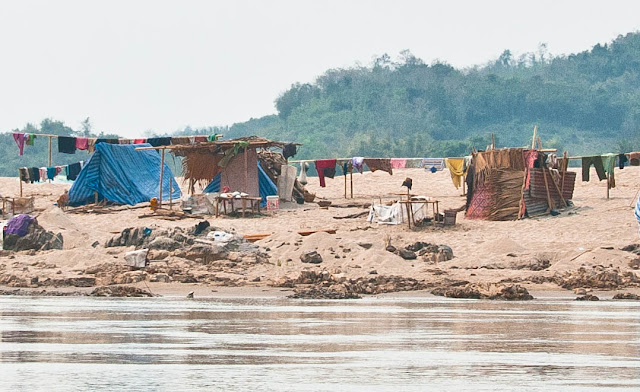In 2009 we had a chance to view the mighty Mekong River from the town of Luang Prabang in Laos. We were so impressed that we started to think about taking our trusty pakboak canoe to Laos to paddle a portion of the river. On February 2nd, 2012 we will head for Thailand to start our expedition. We plan to cross Thailand overland to Chang Khong, situated on the Mekong river across from the border town of Houay Xai, Laos. After crossing into Laos we will paddle to Vientiane, a distance of about 750 km. We hope to have a couple of weeks at the end of our paddle to relax on the exotic beaches of Thailand and perhaps do some birding in the national parks.
Our first stop was Bangkok and we recommend that if you get a chance to visit that city you make it short. The air is so choked with exhaust fumes that our airways felt raw as we walked about getting our supplies. Walking was as efficient as any vehicle as the traffic would rarely move throughout the entire day.

The hotel we reserved was centrally located, quite stylish and excellent value. This first photo is from the roof top where there was a fabulous pool. Bangkok has an extensive canal network which is used by "boat buses" to transport people and goods.


After 5 nights we took an 11 hour VIP bus to Chang Rai in northern Thailand. Here we stayed 2 nights in a lovely garden resort.

From Chang Rai we hopped on a local bus for a 2.5 hr. ride to the border town of Chang Kong. The bus turned out to be older than us and the driver looked to be younger than our children. The license plate revealed that the bus was registered in 1950.

"Oh, Oh. What have I got myself into?"

The bus pulled out and after the driver's wife collected the fares we pulled in for gas. Both the driver and the bus turned out to be excellent and we had a surprisingly pleasant and interesting journey. At Chang Kong we took a tuk-tuk to the border post at the Mekong river and then were ferried across to Huoay Xai, Laos.
Humping the gear down to the ferry to Laos

Looking back towards Thailand

Houay Xai is the starting point for a popular 2 day "slow boat" trip to Luang Prabang. We, however, are redefining the term "slow boat". After clearing immigration we took a room at the Riverside Guesthouse which provided easy access to the Mekong. That evening we enjoyed a table top barbecue dinner on the hotel patio.

The next morning as we were putting together our canoe one of the hotel employees carried 6 large garbage bags down to the river and heaved the whole lot of them into the Mekong beside us. The shoreline was strewn with trash as using the river to carry the garbage away seemed to be standard procedure for the town. Nevertheless we packed our gear and began our expedition in high spirits.

River traffic was common with small private craft hugging the shoreline and slowboats and speed boats carrying passengers and goods. The kings of the river were the large scows carrying heavy cargo. The families that operated them lived on board in a 2 level house built on the stern.




We made ourselves amenable to everyone by smiling and waving a "Sabadee" and felt we were building a rapport with the other river pilots. Each day the return waves seemed to be more enthusiastic as boat operators came to recognize us.



The river felt very remote yet we saw people every day working on the river. They were collecting river weeds and periwinkles for food, doing laundry, panning for gold and bagging sand. There were many small children with them, either helping out or playing on the water's edge. We passed numerous remote primitive villages, mostly small, but occasionally a larger one serviced by a dirt road. A village with a road usually indicated a larger scale enterprise such as a teak farm, a fish farm, a sand collection site, or all of the above.
We also saw cattle, domestic Asian buffalo and goats wandering freely on the shore. They seemed to be on their own in the middle of nowhere. We figured there must be a small village hidden in the forest. We could hear lots of songbirds every day but rarely saw any birds.
Camping and stops for lunch or swimming was super easy on the pristine and soft sandy banks lining the river.


The river was fast and mostly flat. Some days we encountered a series of intense but short rapids. We ran some, lined others and portaged one with the help of some fishermen.



Occasionally we inadvertently made camp next to a local trail. Curious villagers that came upon us would simply sit down on the trail and stare. There they stayed until we offered them some food or water and then they became quite friendly. Communication was, of course only possible by signing.





Eight and a half delightful days after leaving Houay Xai we reached Luang Prabang for a scheduled rest and resupply stop. We were lucky enough to find a guesthouse up the Nam Khan river that had a trail down to the water.We are leaving tomorrow after 3 nights here. Our next entry should be in about 2 weeks when we hope to arrive in Vientienne.





















